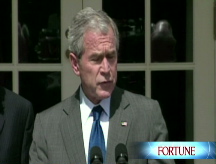Yet another bailout - Taxpayer tally
Big bailouts are in the headlines, and Washington is pledging a lot of money. But what's the real risk to taxpayers?
NEW YORK (CNNMoney.com) -- The numbers are big. That much is certain.
The Federal Reserve has backstopped the purchase of Bear Stearns to the tune of $29 billion. It will loan $85 billion to insurer AIG. It's letting banks borrow up to $150 billion using risky mortgage-backed securities as collateral. And it's letting investment banks, which it doesn't regulate, get short-term loans using the central bank's discount window.
The Treasury, meanwhile, has pledged to backstop Fannie and Freddie up to $200 billion. Lawmakers passed legislation allowing the Federal Housing Administration to insure up to $300 billion in loans for troubled borrowers. They're likely to loan $25 billion to the auto industry.
And the government might not be finished. Some Democrats on Capitol Hill are arguing for an expansion of the FHA program for troubled borrowers. And talk is building that the government might have to set up a fund - similar to efforts in the 1930s and 1980s - to buy bad securities clogging up the financial system.
If you add up how much the Treasury and Fed have pledged or made available for loans so far, it's close to $800 billion.
So what's the real cost to taxpayers for all these interventions? No one can say for sure, and probably won't be able to for some time. The Savings & Loan crisis of the early 1990s cost taxpayers a net of $124 billion in 1999 dollars, according to the FDIC - more than initially estimated but below projections made during the height of the crisis.
But one thing is certain: The price tags on today's bailouts bear "no direct translation to the taxpayer cost," said Lyle Gramley, a former Fed governor now with the Stanford Group, a Washington policy research firm.
Indeed, he said, "None of us knows yet if there'll be any cost to the taxpayer at all."
Here's why: The bailouts are, in one form or another, loans or investments. How much they end up costing (or making) depends on a number of factors including how the economy holds up and when the real estate market recovers.
"A lot depends on whether or not we get in a severe recession and how quickly we turn things around in housing," Gramley said.
In exchange for their stepping in, the Fed and Treasury are getting assets as collateral (in some cases, income-producing assets and saleable assets) as well as majority ownership stakes in AIG, Fannie and Freddie. They've also claimed veto power for corporate decisions and a No. 1 spot among stakeholders who get paid first.
In the case of the Fed's $85 billion loan to AIG, the central bank is charging what are essentially double-digit interest rates: specifically, the 3-month Libor (around 2.88% currently) plus 850 basis points.
So what gains or losses the Treasury and Fed realize will depend on the performance of those assets and stocks, and the companies' ability to pay back their loans. Ultimately those performances rest on how soon confidence is restored to the markets and how the economy fares.
And if there is a cost, it's very likely to be well below the caps the Treasury and Fed have set on their loans and backstops, say Gramley and Rudy Penner, a former director of the Congressional Budget Office and now a senior fellow with the Urban Institute
Some assume "taxpayer risk" means if the government puts up cash, the taxpayer has to pony up more in taxes if the government loses money on the deal. That's not impossible, but usually it's not that direct.
When the Fed steps in to help with cash infusions, it usually produces the money by redeeming the Treasurys in its portfolio. That's not money that has to be raised by taxes or money that adds to the country's deficit, said Diane Lim Rogers, chief economist at the Concord Coalition, a deficit watchdog group, and former chief economist of the House Budget Committee.
But because the Fed pays about 95% of its earnings to the Treasury, booking a loss on an investment reduces the central bank's profits - and that, in turn, reduces how much the Fed can pay the Treasury, Gramley said. So the net effect would be a loss to taxpayers because there would be less revenue in government coffers. That means less to fund programs unless policymakers raise taxes, cut spending or borrow more money.
When Treasury borrows money to finance something (including its promises to help Fannie and Freddie, for instance), the interest it promises to pay is added to the deficit, which is already climbing to record levels.
And long-term, the deficit can hurt taxpayers because it can constrain policymakers' choices and curb economic growth since the government will have to devote more and more of its budget to paying interest on its debt.
One piece of context: The price tags on the recent bailouts are not nearly as scary when compared to the unfunded liabilities the government is facing from say, Medicare, because they're one-time expenditures, said Bob Carroll, a former Treasury official and now vice president for economic policy at the Tax Foundation.
The government stepped in to help Fannie, Freddie and AIG on the premise that their demise would cripple the economy.
One concern was that if they fell, the noose on lending would tighten further. "The last thing we want is to have the banks cut back on lending," Gramley said.
But the knock-on effects could be more widespread. If Fannie and Freddie went under, for instance, the housing industry could seize up, causing the loss of millions of jobs, Gramley said. "The stakes are that big. These measures taken are absolutely essential to keep the economy from utter chaos."
If that's the case, let's hope the economy will be in turnaround sooner rather than later. ![]()


